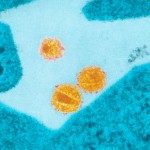Lien vers Pubmed [PMID] – 19218193
Am. J. Respir. Crit. Care Med. 2009 May;179(10):903-13
RATIONALE: Lung injury leads to pulmonary inflammation and fibrosis through myeloid differentiation primary response gene 88 (MyD88) and the IL-1 receptor 1 (IL-1R1) signaling pathway. The molecular mechanisms by which lung injury triggers IL-1beta production, inflammation, and fibrosis remain poorly understood.
OBJECTIVES: To determine if lung injury depends on the NALP3 inflammasome and if bleomycin (BLM)-induced lung injury triggers local production of uric acid, thereby activating the NALP3 inflammasome in the lung.
METHODS: Inflammation upon BLM administration was evaluated in vivo in inflammasome-deficient mice. Pulmonary uric acid accumulation, inflammation, and fibrosis were analyzed in mice treated with the inhibitor of uric acid synthesis or with uricase, which degrades uric acid.
MEASUREMENTS AND MAIN RESULTS: Lung injury depends on the NALP3 inflammasome, which is triggered by uric acid locally produced in the lung upon BLM-induced DNA damage and degradation. Reduction of uric acid levels using the inhibitor of uric acid synthesis allopurinol or uricase leads to a decrease in BLM-induced IL-1beta production, lung inflammation, repair, and fibrosis. Local administration of exogenous uric acid crystals recapitulates lung inflammation and repair, which depend on the NALP3 inflammasome, MyD88, and IL-1R1 pathways and Toll-like receptor (TLR)2 and TLR4 for optimal inflammation but are independent of the IL-18 receptor.
CONCLUSIONS: Uric acid released from injured cells constitutes a major endogenous danger signal that activates the NALP3 inflammasome, leading to IL-1beta production. Reducing uric acid tissue levels represents a novel therapeutic approach to control IL-1beta production and chronic inflammatory lung pathology.
